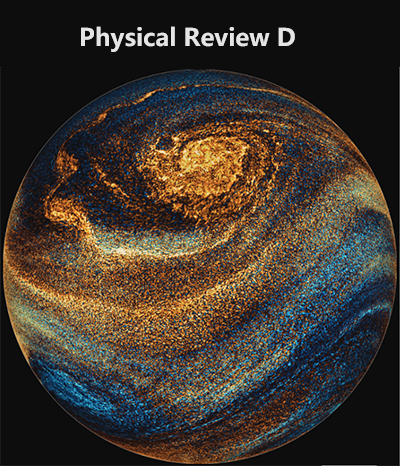Thermal order in conformal theories
IF 5.3
2区 物理与天体物理
Q1 ASTRONOMY & ASTROPHYSICS
引用次数: 42
Abstract
It is widely expected that at sufficiently high temperatures order is always lost, e.g., magnets lose their ferromagnetic properties. We pose the question of whether this is always the case in the context of quantum field theory in $d$ space dimensions. More concretely, one can ask whether there exist critical points (CFTs) which break some global symmetry at arbitrary finite temperature. The most familiar CFTs do not exhibit symmetry breaking at finite temperature, and moreover, in the context of the $\mathrm{AdS}/\mathrm{CFT}$ correspondence, critical points at finite temperature are described by an uncharged black brane which obeys a no-hair theorem. Yet, we show that there exist CFTs which have some of their internal symmetries broken at arbitrary finite temperature. Our main example is a vector model which we study both in the epsilon expansion and arbitrary rank as well as the large rank limit (and arbitrary dimension). The large rank limit of the vector model displays a conformal manifold, a moduli space of vacua, and a deformed moduli space of vacua at finite temperature. The appropriate Nambu-Goldstone bosons including the dilatonlike particle are identified. Using these tools we establish symmetry breaking at finite temperature for finite small $\ensuremath{\epsilon}$. We also prove that a large class of other fixed points, which describe some of the most common quantum magnets, indeed behave as expected and do not break any global symmetry at finite temperature. We discuss some of the consequences of finite temperature symmetry breaking for the spectrum of local operators. Finally, we propose a class of fixed points which appear to be possible candidates for finite temperature symmetry breaking in $d=2$.保形理论中的热序
人们普遍预计,在足够高的温度下,秩序总是会丧失,例如,磁体会失去其铁磁特性。我们提出了一个问题,即在$d$空间维度的量子场论背景下,情况是否总是如此。更具体地说,人们可以问是否存在在任意有限温度下破坏某些全局对称性的临界点。最常见的CFT在有限温度下不表现出对称性破坏,此外,在$\mathrm{AdS}/\mathrm{CFT}$对应关系的背景下,有限温度下的临界点由遵守无毛定理的不带电黑膜描述。然而,我们证明了存在CFT,它们的一些内部对称性在任意有限温度下被破坏。我们的主要例子是一个向量模型,我们研究了ε展开和任意秩以及大秩极限(和任意维度)。向量模型的大秩极限在有限温度下显示了保形流形、vacua的模量空间和vacua的变形模量空间。确定了适当的Nambu Goldstone玻色子,包括类似膨胀粒子。使用这些工具,我们在有限的温度下建立了有限小$\ensuremath{\epsilon}$的对称性破缺。我们还证明了一大类其他不动点,它们描述了一些最常见的量子磁体,确实如预期的那样,在有限温度下不会破坏任何全局对称性。我们讨论了局部算子谱的有限温度对称性破缺的一些结果。最后,我们提出了一类不动点,它们似乎是$d=2$中有限温度对称性破缺的可能候选者。
本文章由计算机程序翻译,如有差异,请以英文原文为准。
求助全文
约1分钟内获得全文
求助全文
来源期刊

Physical Review D
ASTRONOMY & ASTROPHYSICSPHYSICS, PARTICLES-PHYSICS, PARTICLES & FIELDS
CiteScore
9.30
自引率
36.00%
发文量
3456
期刊介绍:
Physical Review D (PRD) is a leading journal in elementary particle physics, field theory, gravitation, and cosmology and is one of the top-cited journals in high-energy physics.
PRD covers experimental and theoretical results in all aspects of particle physics, field theory, gravitation and cosmology, including:
Particle physics experiments,
Electroweak interactions,
Strong interactions,
Lattice field theories, lattice QCD,
Beyond the standard model physics,
Phenomenological aspects of field theory, general methods,
Gravity, cosmology, cosmic rays,
Astrophysics and astroparticle physics,
General relativity,
Formal aspects of field theory, field theory in curved space,
String theory, quantum gravity, gauge/gravity duality.
 求助内容:
求助内容: 应助结果提醒方式:
应助结果提醒方式:


